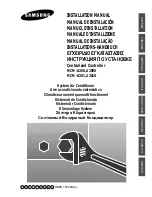
Page 34 of 84
11.5.4 Sequence of Operation for 20-100%
Modulating Furnace with 250-400 MBH (73.3-
117.2 kW) Input
When system is powered up 24 VAC will be applied to the
ignition control (ignition control) terminals 24VAC / R and
to the timer relay control.
The ignition control will reset, perform a self check
routine, flash the diagnostic LED for up to four seconds
and enter the thermostat scan standby state. The amber
light on the timer relay control will be lit indicating it is in
the ready position.
Call for Heat:
1. Controller provides contact closure on call for heat.
2. 24VAC to is supplied to ignition control terminal TH,
provided limit switch is in closed position.
3. The control will check that pressure switch contacts are
open (ignition control terminal PSW is not powered).
4. Combustion blower is then energized at high speed.
5. When the airflow switch closes, a 15 second pre-purge
period begins.
6. At end of pre-purge period, the spark commences
and the 1st stage gas valve is energized for the trial for
ignition period. (If the burners fail to light or carryover
during a trial for ignition, the control will attempt two
additional ignition trials. If no flame is present at the
flame sensor within 10 seconds, the spark and gas
valve will be de-energized. A 15 second inter- purge
period begins and the combustion blower continues to
run. After the inter-purge period another ignition trial
will take place. If burner fails to light or prove the flame
sensor following the two additional trials the control
will go into lockout. The valve relay in the ignition
control will be de-energized shutting of the gas valve
immediately and the combustion blower following
a 30 second post-purge period. If the thermostat
(controller) is still calling for heat one hour after a
lockout occurs, the control will automatically reset and
initiate a call for heat sequence.)
7. Burners ignite and cross light. Timer relay control
is powered (terminal 7) simultaneously and begins
timing a 90 second warm-up period while maintaining
the combustion blower at high speed and powers
the SC30. The SC30 will output 12 to 13VDC to the
modulating control valve during the timing duration
(90 seconds) of timer relay control regardless of the
analog input signal to SC30 terminals 7 & 8.
8. When flame is detected by flame sensor, the spark is
shut-off immediately and gas valve(s) and combustion
blower remain energized.
9. When the initial timer in timer relay control times out,
it defaults the gas valve to low fire and the combustion
blower to low speed and returns control of the
operating mode to the building temperature controller.
10. If the controller is providing an analog signal between
0.5 and 5.3VDC to the SC30 control, the system will
continue to run at low speed combustion blower and
with only the 1st stage valve open. The modulating
valve will be powered proportional to the input
voltage signal from the controller, and will open or
close changing the gas manifold pressure. Manifold
pressure will vary from 0.3 to 1.2 “w.c. (0.75-3.0 mbar)
operating in this mode.
11. If the signal increases above 5.3VDC, the SC30 relay
closes powering terminal 6 on the timer relay control,
and starts a second time delay of 15 seconds. At the
end of this time delay the fan switches to high speed
and the 2nd stage gas valve opens through the timer
relay control (terminal 9) provided the high air switch
contacts are closed. The manifold pres- sure will vary
from 1.4 to 3.5” w.c. (3.5-8.7 mbar)in this mode.
12. During heating operation, the thermostat, pres-
sure switch and main burner flame are constantly
monitored by the ignition control to assure proper
system operation.
13. Operation continues in the high fire mode until the
controller input signal to the SC30 control drops to
4. VDC. At this point the SC30 relay circuit opens
(SC30 terminal 5 has no output) de-energizing the 2nd
stage valve and the timer relay control switches the
combustion blower to low speed operation. Low-fire
modulation will continue as in Step 10.
14. When the thermostat (temperature controller) is
satisfied and the demand for heat ends, the heat
enable contact opens and the 1st stage valve is de-
energized immediately, the control senses loss of
flame and a 30 second post- purge occurs (at high
speed) before de-energizing the combustion blower.
PR Series Installation, Operation, and Maintenance Manual
















































